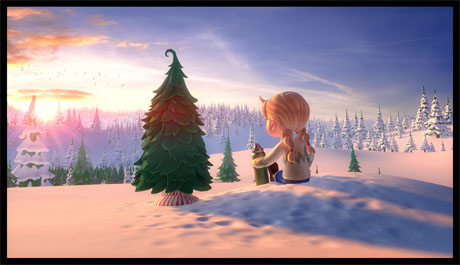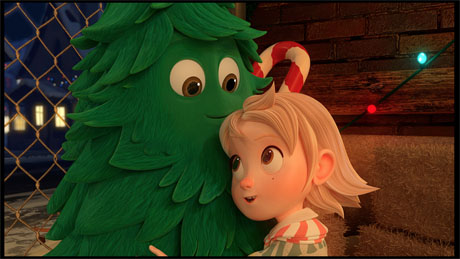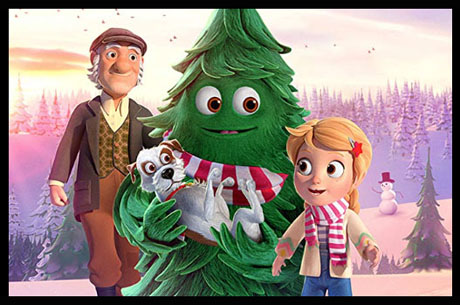
Piney: The Lonesome Pine is a terrific 26-minute special that is currently looking for U.S. distribution. It’s also in the hunt for this year’s Best Animated Short Film Oscar. Directors Todd Edwards (Hoodwinked!) and Timothy Hooten adapt a beloved book into this CG short perfect for the holiday season.
Todd Edwards: The story was brought to us by the author, Jane West Bakerink. It was a book. And basically we got involved to bring it to the screen. The goal was always to make something that was a classic tone. We weren’t going for cheap laughs. It’s something that has the feeling of the types of holiday specials we all grew up on – the feeling of “Charlie Brown” or “Rudolph the Red-Nosed Reindeer”. It was great we were really on the same page with the executive producers on wanting to deliver that kind of classic tone in a world that wasn’t bogged down with the sort of modern… cynicism. [It’s] something from a more innocent time. We really made an effort to make sure those characters had that feeling of something older.

Todd Edwards: We had great voice talent that came in on this. Jonathan Pryce plays the grandfather. He brings a gravitas to it that is undeniable. And he is from the Welsh area where the story takes place. And we had some other great actors… Simon Pegg is the scrappy dog character. So it turned into an awesome for experience for Tim and myself and our producer Katie [Hooten]. The three of us have a company called Hardy Howl Films. It turned into a little labor of love for us.
Jackson Murphy: And that classic tone shines through, especially with the music.
Timothy Hooten: Like Todd said, we’re huge fans of Rankin-Bass, so we really wanted to support that tone with the score. The executive producers brought on Timothy Williams who did the score. And it was really fun to collaborate with him. Todd and I actually also included a song of ours in the short. We couldn’t do it all in the jazz tones of “Charlie Brown”. That has become a soundtrack that’s nostalgic and we’re very familiar with. There’s a touch of that. There’s a touch of Danny Elfman in it. There’s a touch of John Williams. A lot of people probably don’t know that John Williams was the composer for “Home Alone”, which is a really classic Christmas soundtrack.
JM: “Piney” is about a little girl named Georgie and her grandfather in a Welsh town. Georgie becomes emotionally attached to this Christmas tree. She’s the only one that can talk to it – and the tree talks back to her. Tell me about deciding who gets to communicate with who. About halfway through Jackster the dog suddenly talks. How did you craft that?
TH: Todd and I are a writing and directing team. The first thing that we do is look at the script and see how we can transition it from that document to a tight story within the confines of a TV special length. So there was a lot that we needed to edit out of the story. There were elements that we added. We also have an additional story materials credit on this because there were significant things we needed to adjust. Part of that was creating some consistent rules.
In the original story… there’s no distinction. Anyone can talk to the tree. It’s kind of no holds barred. And we wanted to put it in those classic “Toy Story” rules where it narrows the scope of who can communicate – and to make it feel a little more magical. And one of the places in this short where I think this really stands out is when the bus driver pulls up… when both Piney and Jackster are on their adventure trying to get back to Georgie. And the bus driver pulls up and she’s seeing a tree and a puppy dog out lost in the snow waiting at a bus stop. We’re seeing both sides of the conversation. We tried to make it clear by being consistent with the camera angles we chose for different moments.

JM: And I love the shot where the bus and the car separate. There is a lot of power in that shot.
TH: It’s a heartbreak! Todd and I both have kids. We’ve watched it with our kids, and that’s just the worst part for them – to see that moment.
TE: They’re like, “Oh No!” They’re going in separate ways and not aware.
TH: So close! So close!
JM: Todd, I gotta ask you about Hoodwinked! because 14 years ago, this was the first movie I ever reviewed. I started my career with Hoodwinked! How much fun was it making that movie? It’s so iconic in the animation world, with Twitchy and all the different characters.
TE: Thanks for saying. I think when we started that project, we didn’t know what it would become. We certainly had a lot of hopes for it. It was born out of an independent spirit. We kinda just didn’t know that we couldn’t do it. We had a little bit of experience in the animation field. And it was kind of like the wild west, but bringing our live-action sensibilities where we really focused on the script – to get it to a locked place. The story reel was a very quick pace. It was not normal for what a feature film would normally do in animation. You might normally spend 12 months on your reel. We spent like 3 months on it. In some ways, the limits sort of propelled us forward. And I think once we had it in that animatic form, it started to feel like, “Okay – we might really have something on our hands here” because we can show this to a bunch of kids and they’re already into it, and we haven’t even started animation yet.
The talent we got involved: Patrick Warburton was on early on. Once we got Patrick we were like, “We’re making a movie, folks!” That’s when it suddenly started to get real. It was a crazy, wild west indie movie experience that luckily had a happy ending.

JM: And what “Hoodwinked!” did really well was throw-in a lot of jabs at the fairy tale world – and clever lines. You have a couple of holiday season jabs in “Piney”.
TH: I do the voice of the snowman at the end. And that was something Todd and I wanted to add into the story with that little joke…
TE: “Let me guess, you talk too.”
TH: Piney leans in and says that and Jackster says, “Are you kidding me? There’s no such thing as a talking snowman – but his nose looks delicious.” [It’s a carrot.]
TE: We have a big snowman surprise at the end, and it’s pretty crazy. And Tim was like, “I think we gotta go for it.” It’s a little bit out there, and it will leave people smiling as we go into the credits. And I was like, “Let’s try it out!”
TH: There are several moments like that. Another one we really love how it came off is: there’s this breaking the fourth wall that Jackster does. One time it’s just slightly, another time it’s unmistakable. And we call that “Jackster’s Jim from The Office look”. One of the things that makes this story classic is that it’s very earnest. It’s not a comedy like the DreamWorks or Illumination films that families are used to seeing in more recent years. Because of that more earnest tone, we couldn’t pack it with a lot of the physical humor that we like. There’s not a Twitchy kind of character in this story. We tried to support that with little moments.
We hope this becomes a new, favorite Christmas classic where you wanna pour yourself a cup of cocoa or a cup of Christmas tee and just have it playing – and have the environment bring the magic of this Welsh town into your home, supported by the great music.
JM: When I go get my Christmas tree this year, I will take even more time doing it. There are several scenes in this short where it shows that people are very particular about their Christmas tree.
TH: It’s so true what you say, and that was something that attracted us to this story – and we really tried to illuminate. It’s this idea of resiliency. You got this little tree. He’s got a plan for himself. He’s always known who and what he wants to be. And when life throws him a curveball, how does he respond to that? We hope that is a touching message to people because… what inspired the author Jane was: one day driving past a Christmas tree lot after Christmas and seeing that there were still beautiful trees there and wondering, “Why weren’t they chosen?” “What left them there, and what happens to them next?” We tried to handle that in a tasteful and artful way. We really feel like we accomplished it.
- INTERVIEW: Strap In For “Mars Express” - April 30, 2024
- INTERVIEW: Jeff Fowler On “Knuckles” And “Sonic 3” - April 22, 2024
- INTERVIEW: “Inside Out 2” Director And Producer On Pixar Sequel - April 16, 2024


 November 18th, 2019
November 18th, 2019  Jackson Murphy
Jackson Murphy  Posted in
Posted in  Tags:
Tags: 






